Astronomers have long suspected that a distant quasar harbors not one but two supermassive black holes. They’ve now detected OJ 287’s second black hole.
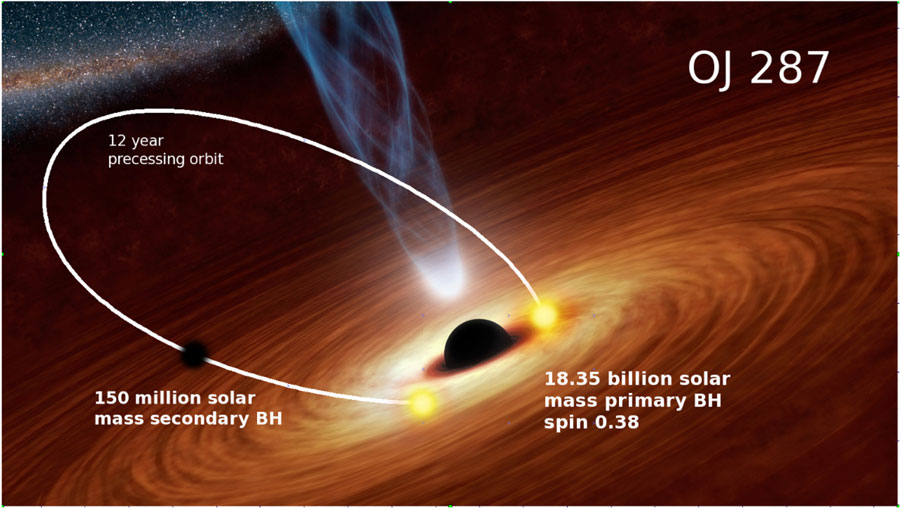
Lankeswar Dey et al. / Astrophysical Journal 2018
Astronomers have long suspected that the distant galaxy OJ 287 harbors not one but two supermassive black holes in its core — one with the mass of a whopping 18 billion Suns, the other a relatively diminutive, 150-million-solar-mass companion. Researchers have been observing and closely monitoring the galaxy for decades in the hopes of securing firmer evidence for the presence of the secondary black hole.
And now they have. A large international team led by Mauri Valtonen (University of Turku, Finland) announced at the 242nd meeting of the American Astronomical Society the detection of the signature of the second black hole in this distant galaxy.
It's in the Light Curves
The light from OJ 287 travels some 4 billion light-years to Earth from the constellation Cancer, where the galaxy sits near the ecliptic just a few degrees from the Beehive Cluster (M44). This means that, serendipitously, OJ 287 appears in astronomical photographs from 1888 (as astronomers were searching for minor planets).
In the 1980s, Aimo Sillanpää (University of Turku Observatory, Finland) and colleagues dipped into the long archive of photographic plates to construct a light curve showing how OJ 287 varied in brightness over the past century. Analyzing the dataset, they noticed weeks-long outbursts approximately every 12 years, as well as another 55-year cycle in the galaxy’s emission. They attributed the repeating patterns to a pair of black holes orbiting each other: The 12-year cycle arises from a secondary black hole orbiting the primary, while the 55-year cycle is due to the system's slowly changing orientation.
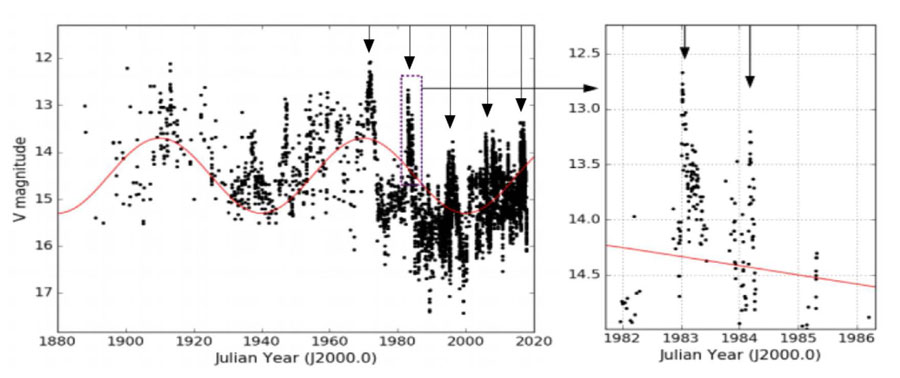
Lankeswar Dey et al. / Astrophysical Journal 2018
Further scrutiny of the light curves revealed that the 12-year cycle presented an additional feature: a double outburst. Sillanpää, Valtonen, and colleagues interpreted these flares as arising when the secondary black hole plunged through the primary black hole’s accretion disk. Models of the double-black hole system provided estimates of their mass as well as their orbit, which had to be oblong to explain the observations. Those models also predicted when the next flares would occur — predictions that bore out time and again.
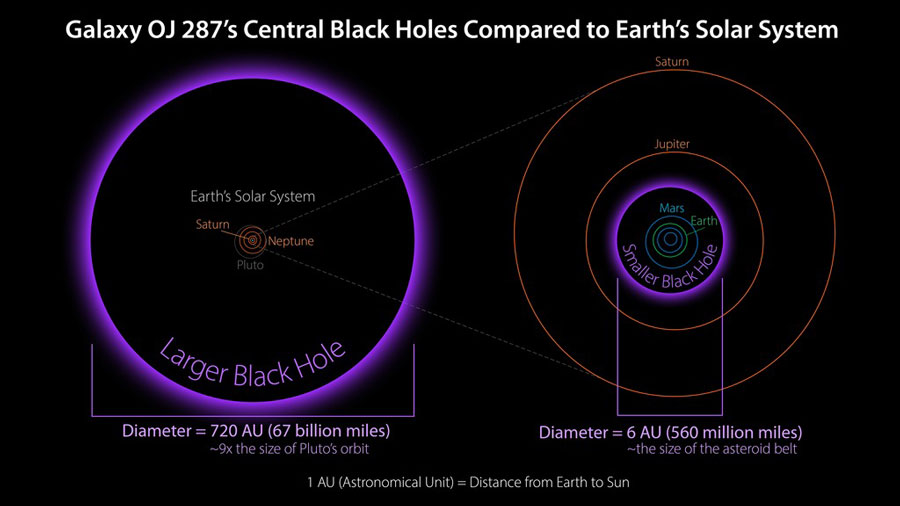
NASA / JPL-Caltech / R. Hurt (IPAC)
But astronomers still craved firm evidence — in spite of all these observations, they still didn’t have a direct signal from the secondary black hole.
“The two black holes are so close to each other in the sky that one cannot see them separately; they merge into a single point in our telescopes,” says Valtonen. “Only if we can see clearly separate signals from each black hole can we say that we have actually ‘seen’ them both.”
Seeing Double
In 2021 and 2022, the team unleashed a large campaign to observe OJ 287 based on the secondary black hole’s predicted plunge through the accretion disk. Astronomers around the world carried out observations at wavelengths ranging from visible light to ultraviolet to X-rays, as well as radio waves.
The astronomers saw an expected signal right after the secondary plunged through the accretion disk within days of the predicted time. But that wasn’t all. The multiwavelength campaign also yielded two observational surprises.
The first surprise came from Staszek Zola (Jagiellonian University, Poland), who recorded a flare in the R band at the predicted time. But this one was huge, with an energy output 100 times that of an entire galaxy — and it only lasted one day!
Analysis of the data indicated that this short flare occurred shortly after the secondary black hole, during its plunge through the accretion disk, “swallowed” a massive dose of new gas, which resulted in the whole system suddenly brightening. “It is thought that this process has empowered the jet, which shoots out from the smaller black hole of OJ 287,” explains Valtonen. “An event like this was predicted 10 years ago but has not been confirmed until now.”
But why haven't astronomers seen this flare prior to this observation? It turns out it’s simply rotten luck. With an event lasting only one day, it’s easy to miss. Without tight monitoring such as that of Zola’s, “we would have missed it this time as well,” Valtonen states.
The second surprise came in the form of a spurt of gamma rays, which the Fermi satellite detected. When the smaller black hole crashed through the disk, its jet interacted with the gas in the disk to produce gamma rays. To confirm that this was indeed what they were seeing, the researchers trawled through archival gamma-ray data and found a similar gamma-ray flare from 2013 that coincided with the secondary plunging through the accretion disk.
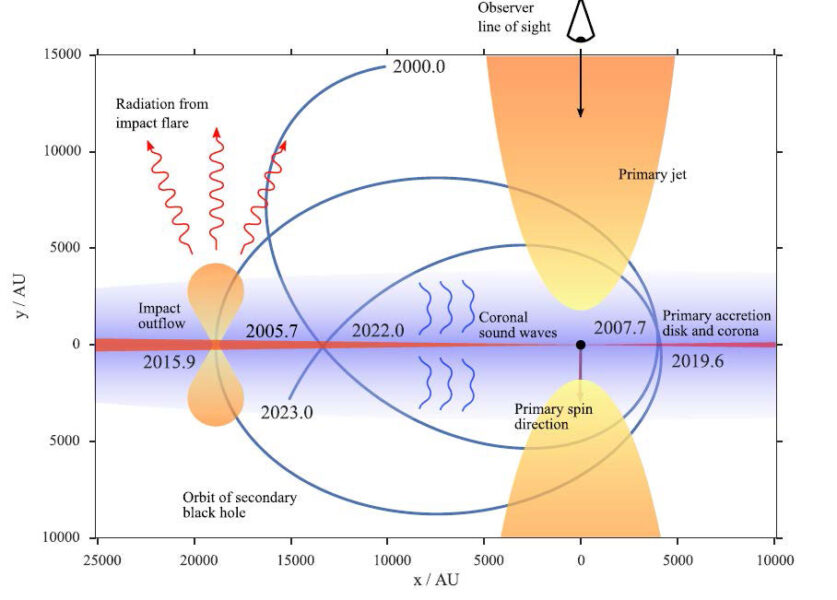
Valtonen et al. / Astrophysical Journal 2016, with modifications by Pauli Pihajoki
Pulling all this together, Valtonen and his team determined that in these flares we’re directly seeing three stages of the secondary black hole’s interaction with the primary’s accretion disk:
- The one-day flare signals the secondary black hole “swallowing” extra gas as it plunges at high velocity through the primary’s accretion disk,
- The gamma-ray flare is coincident with the secondary’s jet interacting with the disk,
- The weeks-long flare reveals the exit of the secondary from the accretion disk of the primary.
And so, they conclude, with this trio of flares, we've seen evidence that a secondary black hole orbits the primary.
A tantalizing RadioAstron observation from 2014 shows something interesting: In the image below, the expected jet from the primary extends through blobs C1a, C2, and J6. The blob labeled C1b shouldn't be there. However, according to Dey, Valtonen, and their colleagues, that's the calculated position of the secondary jet. So might we be seeing a direct image of the jet of the secondary black hole in OJ 287? That remains to be seen. RadioAstron is no longer, and next-generation space radio interferometry is far in the future.
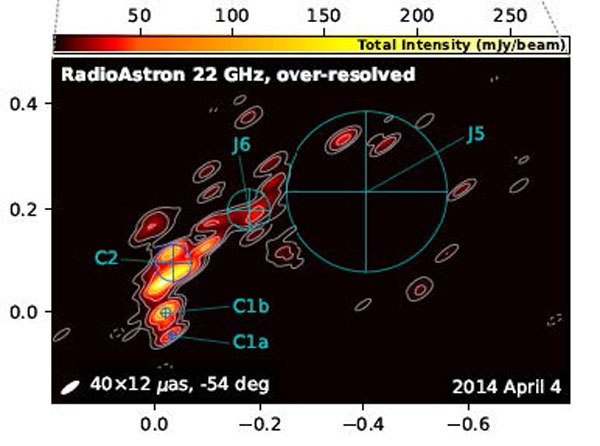
José L. Gómez et al. / Astrophysical Journal 2022
All of this makes OJ 287 a prime candidate for detecting gravitational waves at nano-hertz frequencies, putting it within range of pulsar timing arrays. And as the system emits gravitational waves (even if we can't yet see them), the orbital period shrinks, until eventually the pair will spiral together. “Thus,” Valtonen explains, “the merger is due after about 1,000 periods, or 10,000 years.”
Some far-future gravitational wave detector will no doubt capture this signal.
 6
6









Comments
Anthony Barreiro
June 16, 2023 at 6:01 pm
This is fascinating. Thanks for explaining these findings in a way that this layperson can (mostly) understand. The wikipedia page for OJ 287 says it's a BL Lacertae object with a visual magnitude of 15.43. So on those 19th century photographic plates it would have looked like just another very faint star, not a nebula. It would be interesting to see one of those old images with OJ 287 highlighted. I'm also curious when OJ 287 was first identified as a quasar -- presumably after 1968, when John Schmitt figured out that BL Lacertae was a quasar and not a star.
You must be logged in to post a comment.
Bruce Frahm
June 16, 2023 at 10:28 pm
“The two black holes are so close to each other in the sky that one cannot see them separately; they merge into a single point in our telescopes,” says Valtonen. “Only if we can see clearly separate signals from each black hole can we say that we have actually ‘seen’ them both.”
We all know what Valtonen means here but talk of seeing signals 'from' a black hole seems absurd at face value.
The diagrams showing the diameters of the two black holes are amazing. 18 billion suns' mass is of course immense, but at black hole density I'd have guessed a much smaller diameter. I also have trouble with there being "only" 10^81 atoms in the universe. I realize powers of 10 span vast ranges but have difficulty accepting they account for "everything".
You must be logged in to post a comment.
Tom Kellogg
June 16, 2023 at 10:42 pm
Excellent article. 15 years of observing records is amazing and 18 billion solar masses is fodder for a science fiction novel. I love all of the details included and what it all does for my imagination of our amazing universe. I too am surprised by the calculated diameters of the 2 black holes.
You must be logged in to post a comment.
Val Ricks
June 17, 2023 at 1:09 pm
Excellent report! Thank you for walking us through the actual observations and through the science in a technical but non-mathematical way. This is part of what attracted me to S&T decades ago and still draws me in.
You must be logged in to post a comment.
Bruce Frahm
June 18, 2023 at 2:32 pm
Google confirms (actually claims slightly bigger) largest black hole diameter. {I'm not strong in math but} I can't make this come close to working out. Isn't solar density 1400 kg/m^3 and black hole density 2 x 10^19..... more than 10^16 denser?
And I THINK the diagrammed black hole volume is ~ 4.55^14 more than the sun. Doesn't that make the mass of this solar system-sized black hole way more than 20 billion suns? Like 10^32 more? Where am I going wrong?
You must be logged in to post a comment.
Yaron Sheffer
July 7, 2023 at 2:42 pm
Bruce, the more massive and larger a BH is, the smaller the density. In fact, the density goes down as the square of the radius. Thus OJ 287 has a density about 1/10^20 of that of a solar BH.
You must be logged in to post a comment.
You must be logged in to post a comment.